A Simple Router for WordPress Plugins
💡
This article was originally published in 2010 and was deliberately preserved as it was written for WordPress 3.0, released in June 2010, when custom post types and menus were introduced. It still works for WordPress 6.7.1 in 2024, and you can find the updated article here
I was working on creating a simple CRM plugin for WordPress. My first plugin yet. I needed something lightweight and very specific to my work in real estate. After some searching, I didn’t find anything suitable- unsurprisingly.
So, I set out to make this plugin. I divided the functionality into two parts. The first: basic CRM functions to view contacts, reminders, opportunities, etc. The second: advanced features like syncing, auto-reminder templates, and automated emails.
After creating my first single-handed website with Kohana 2.4, I realised the importance of an administrative backend – not just any admin panel, but something apt for managing the site AND adding new functionality.
ere’s where I learnt the point of CMSes, really only because I hate tiresome learning curves, and eventually – because I was already using it: WordPress.
Don’t get me wrong; I absolutely LOVE Kohana and am already trying to master Kohana 3, but that’s a topic for another day. Before I digress further from this (intended short!) introduction, let’s better get started.
I’ve grown too comfortable with the MVC approach, where URL segments map to methods in a controller. After dissecting a few plugins, I realised WordPress doesn’t really have a straightforward router to decide which method or function runs. So, I decided to create a utility class to handle routing. It wouldn’t change how the URLs look but would at least know what to run automatically.
The Router Class
class Router
{
/**
* Sets up the routing logic based on provided controller, method, and arguments.
* Falls back to defaults if specific routes are unavailable.
*
* @param array $route [controller, method, args]
* @param string $default_controller Default controller to use
* @param string $default_method Default method to use
*/
public function __construct($route, $default_controller, $default_method)
{
// Attempt specified route, fallback to defaults if it fails
$try = $this->route_it($route, $default_method);
if ($try === false) {
$this->default_route_it(
$default_controller,
$default_method,
$route[2]
);
}
}
/**
* Attempts to execute the specified route (controller, method, args).
*
* @param array $route [controller, method, args]
* @param string $default_method Default method to fallback to
* @return mixed
*/
public function route_it($route, $default_method)
{
$controller = $route[0];
$method = $route[1];
$parameters = $route[2] ?? null;
$obj = is_object($controller) && ($controller instanceof $controller)
? $controller
: (class_exists($controller) ? new $controller() : false);
if (!$obj) {
return false;
}
return method_exists($obj, $method)
? $obj->$method($parameters)
: (method_exists($obj, $default_method)
? $obj->$default_method($parameters)
: false);
}
/**
* Fallback to default controller and method if routing fails.
*
* @param string $controller Default controller
* @param string $method Default method
* @param mixed $parameters Optional arguments
* @return mixed
*/
public function default_route_it($controller, $method, $parameters = null)
{
$obj = is_object($controller) && ($controller instanceof $controller)
? $controller
: (class_exists($controller) ? new $controller() : false);
if (!$obj) {
return false;
}
return method_exists($obj, $method)
? $obj->$method($parameters)
: false;
}
} Of course, this is a very basic class. We could probably enhance with error and/or exception or autoload classes in the include path but I this is the basic idea behind the router.
Using the Router in the Parent Controller
I decided the respective controllers would be defined in the $_GET['page'] variable since that’s how WordPress admin navigates plugin pages. The method would come from $_GET['action']. Finally, the remaining $_GET variables would be the arguments.
Here’s how it might look:
class CRM
{
public function __construct()
{
// Initialize the request handler for routing plugin functionality
$request_handler = [$this, 'request_handler'];
// Add main menu and submenu entries for the plugin
add_menu_page(
'MY CRM',
'MY CRM',
4,
'?page=CRM',
$request_handler
);
add_submenu_page(
'?page=CRM',
'Contacts',
'Contacts',
4,
'?page=CRM',
$request_handler
);
add_submenu_page(
'?page=CRM',
'Opportunities',
'Opportunities',
4,
'?page=CRM_Opportunities',
$request_handler
);
add_submenu_page(
'?page=CRM',
'Reminders',
'Reminders',
4,
'?page=CRM_Reminders',
$request_handler
);
}
/**
* Processes incoming requests and invokes the router.
*/
public function request_handler()
{
// Determine the controller from the "page" parameter
$controller = $_GET['page'];
// Default to "index" if no action is specified
$action = $_GET['action'] ?? 'index';
// Check if the request is for the current class
if ($controller == get_class($this)) {
$controller = $this;
}
// Extract additional parameters from GET variables
$params = $_GET;
unset($params['page'], $params['action']);
// Define the route for the router
$route = [$controller, $action, $params];
// Route the request using the Router class
$router = new Router($route, $this, 'index');
}
/**
* Default method when no specific action is specified.
*/
public function index($args = null)
{
echo "Welcome to My CRM.......";
}
}
class CRM_Opportunities
{
/**
* Displays the opportunities page.
*/
public function index($args = null)
{
echo "The Opportunities Page";
}
/**
* Handles the "edit" action for opportunities.
*/
public function edit($args)
{
if ($_POST && !empty($args['id'])) {
// Process data for editing an opportunity
}
}
/**
* Handles the "delete" action for opportunities.
*/
public function delete($args)
{
// Logic to delete an opportunity
}
} Example
If WordPress admin points to:
wp-admin/admin.php?page=CRM
The CRM controller runs, and since no action is specified, it defaults to the index() method.
If the URL is:
wp-admin/admin.php?page=CRM_Opportunities&action=edit&id=1
The CRM_Opportunities controller loads, and the edit() method runs with the id argument.
Here are some screenshots:
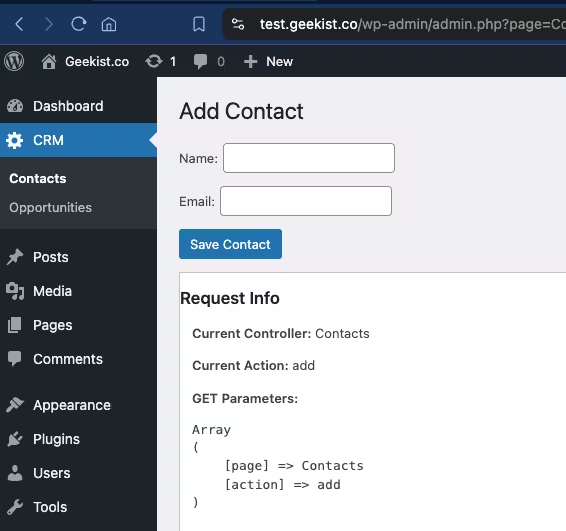
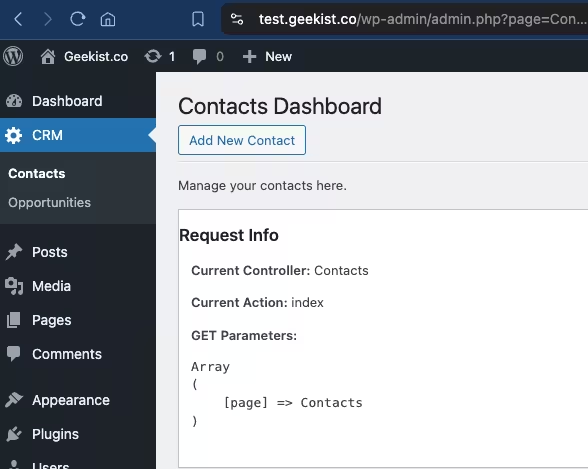
Closing Thoughts
You’ll still need to sanitize input and clean POST data, but this should give you an idea of implementing a simple router for controllers in plugin development.
Let’s discuss in the comments!
Related Posts.

The 5 Best Downloaders for Videos, Music & Images (No Browser Needed)
Remember downloading at 4KB/sec? These five modern tools are faster and don’t… Read More
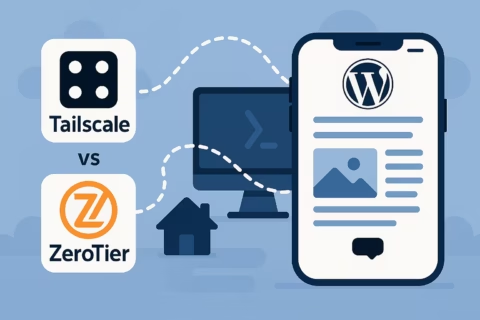
Yes, you can Blog from your Localhost WordPress on iPhone.
Access your local WordPress site from your iPhone using ZeroTier or Tailscale.… Read More
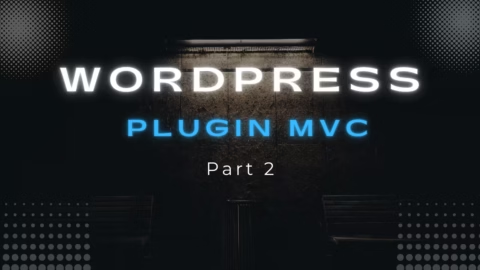
Modern WordPress MVC Plugin (2024)
Revisiting a 2010 MVC router for WordPress plugins, now updated for 2024… Read More
References (1)
Linked from Modern WordPress MVC Plugin (2024)6 responses to “WordPress MVC Plugin Development”
commented on
Interesante, no va a continuar con este artнculo?
Gracias
commented on
Thanks. I have been too busy.., but do miss my blog… 🙂
commented on
I’d like to know where you instantiate the ‘my_crm_main’ in order to make it load and execute the constructor procedures.
Do you set an instance of it in the same php file after or before you declare the class, like this?
class my_crm_main {...
}
$my_crm_main = new my_crm_main();
I don’t see a way to instantiate a plugin class in WordPress if not by these means, so I’m very curious to know how you made it.
BTW, this is an awesome post, and I’ll make use of your example if you permit me.
Thanks a lot!
commented on
Hey Denis, thanks for your comment. The class is ‘auto loaded’ through the
. When you create your plugin menus, you’d have to define a callback function. In this case the callback function is
method in the example above. That method decides which of your controllers (classes) to instantiate.
And of course you can use it!
commented on
hi ,
i just try to use your router but it not work properly .
when i use the following url is not go to the specific action
can you give me , your any sample plugin with the router ? it will be helpfull to understand your router . Please send me it ASAP .
commented on
Hey Imran , sorry I don’t have an example right now. What problems are you having? Did you create the WP Admin menus and specify a callback function like I did above? Also, all the class files must be included in your plugin loader file. IE,
include_once('my_class_file.php'):